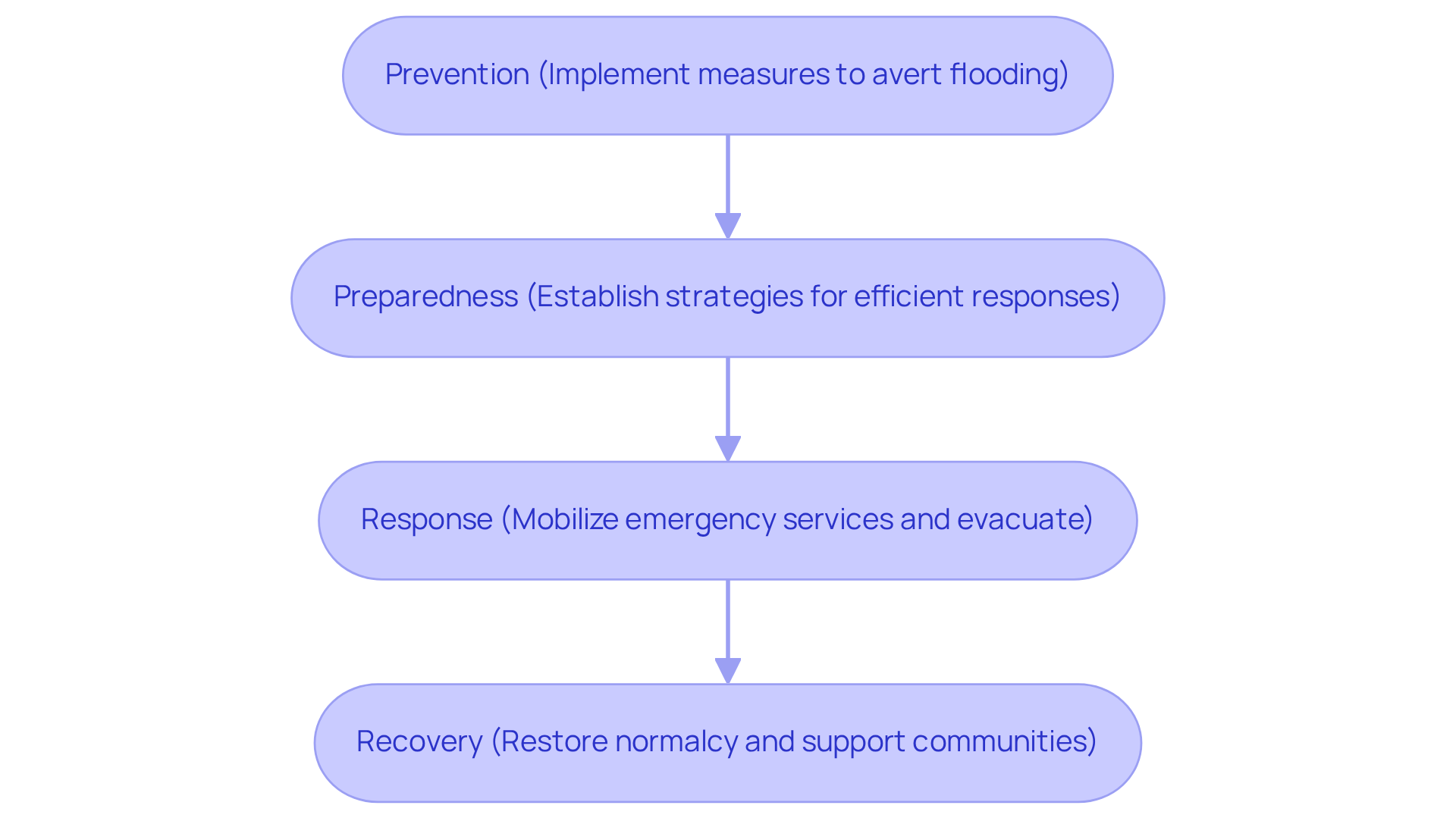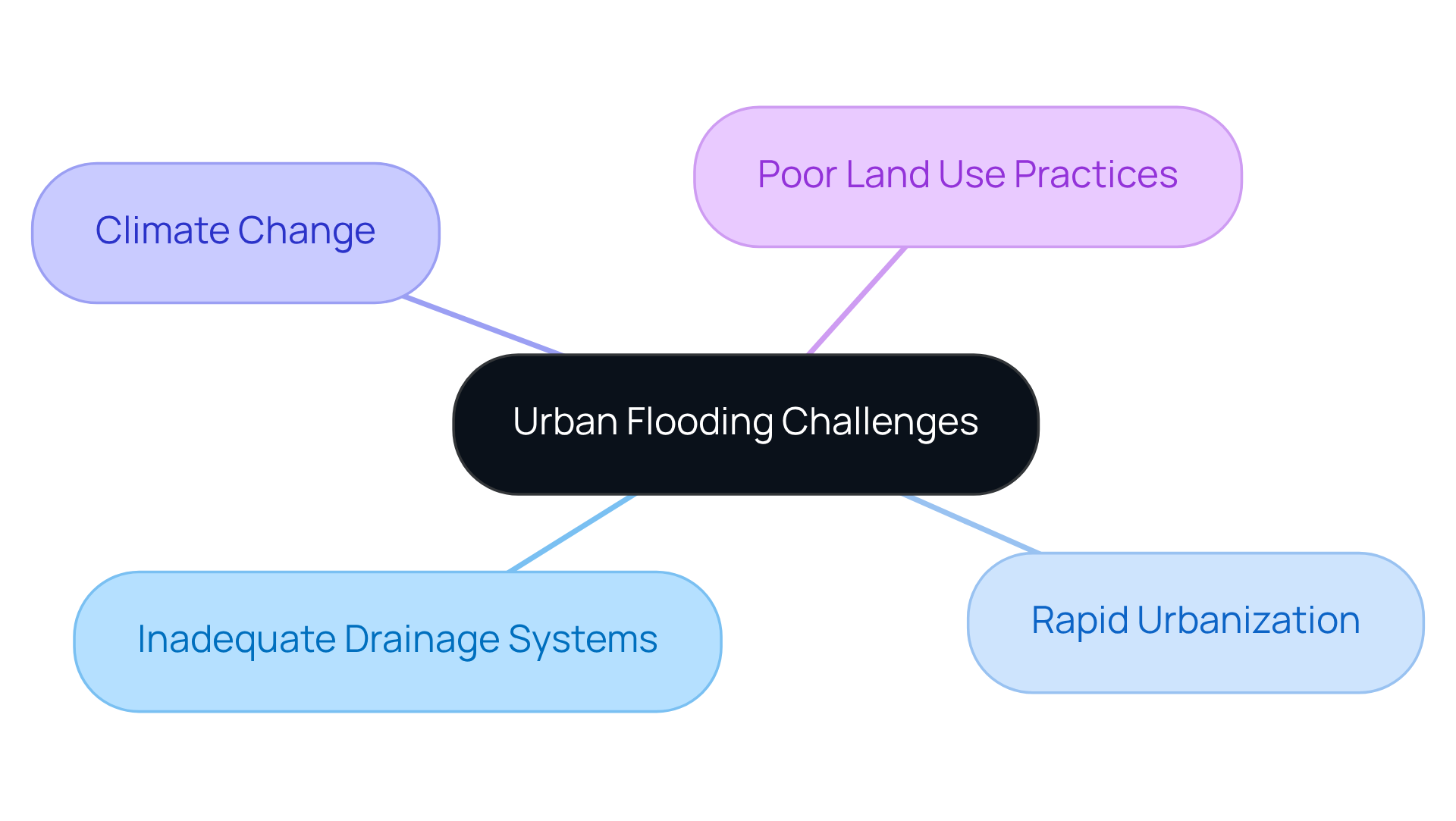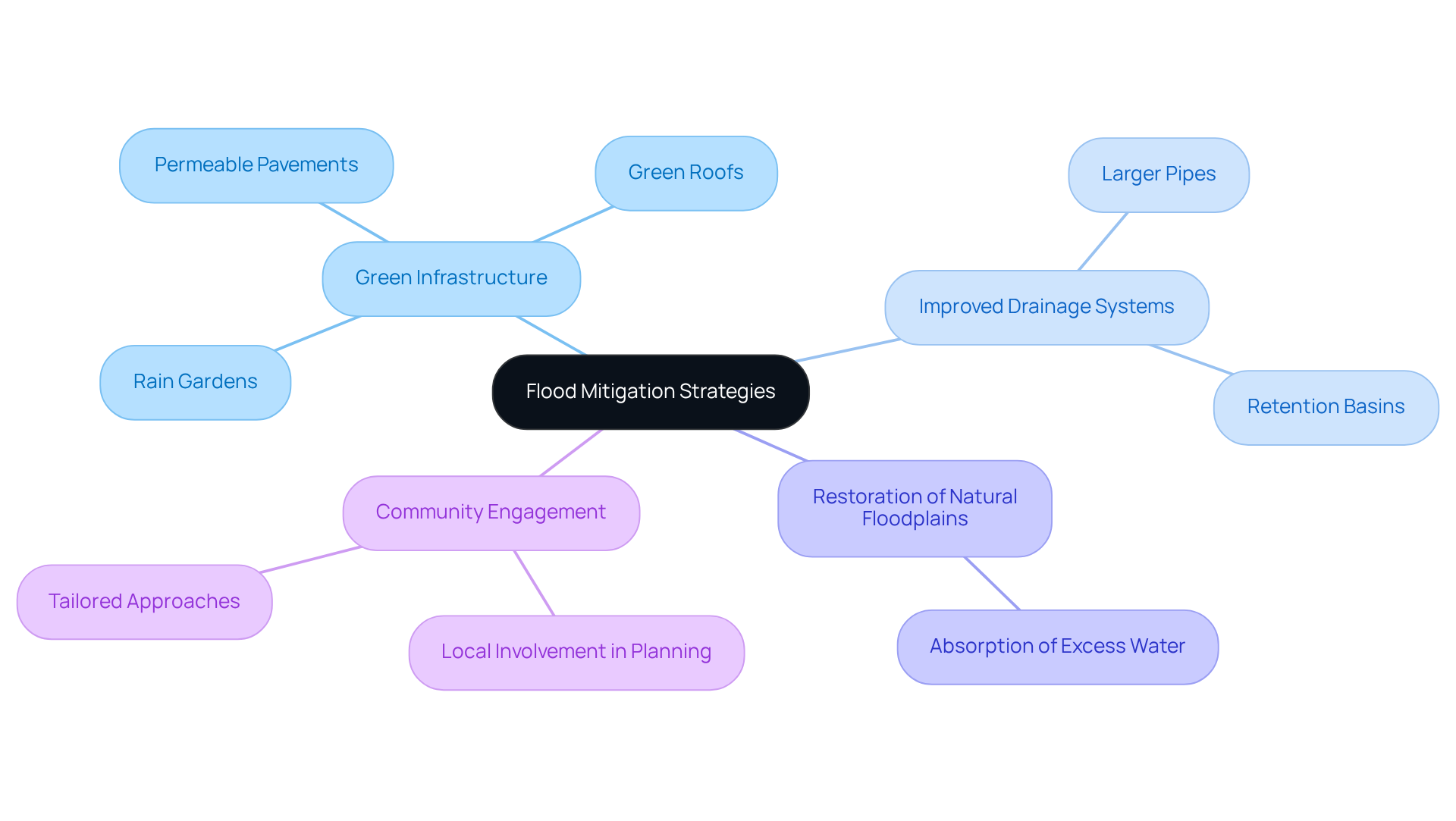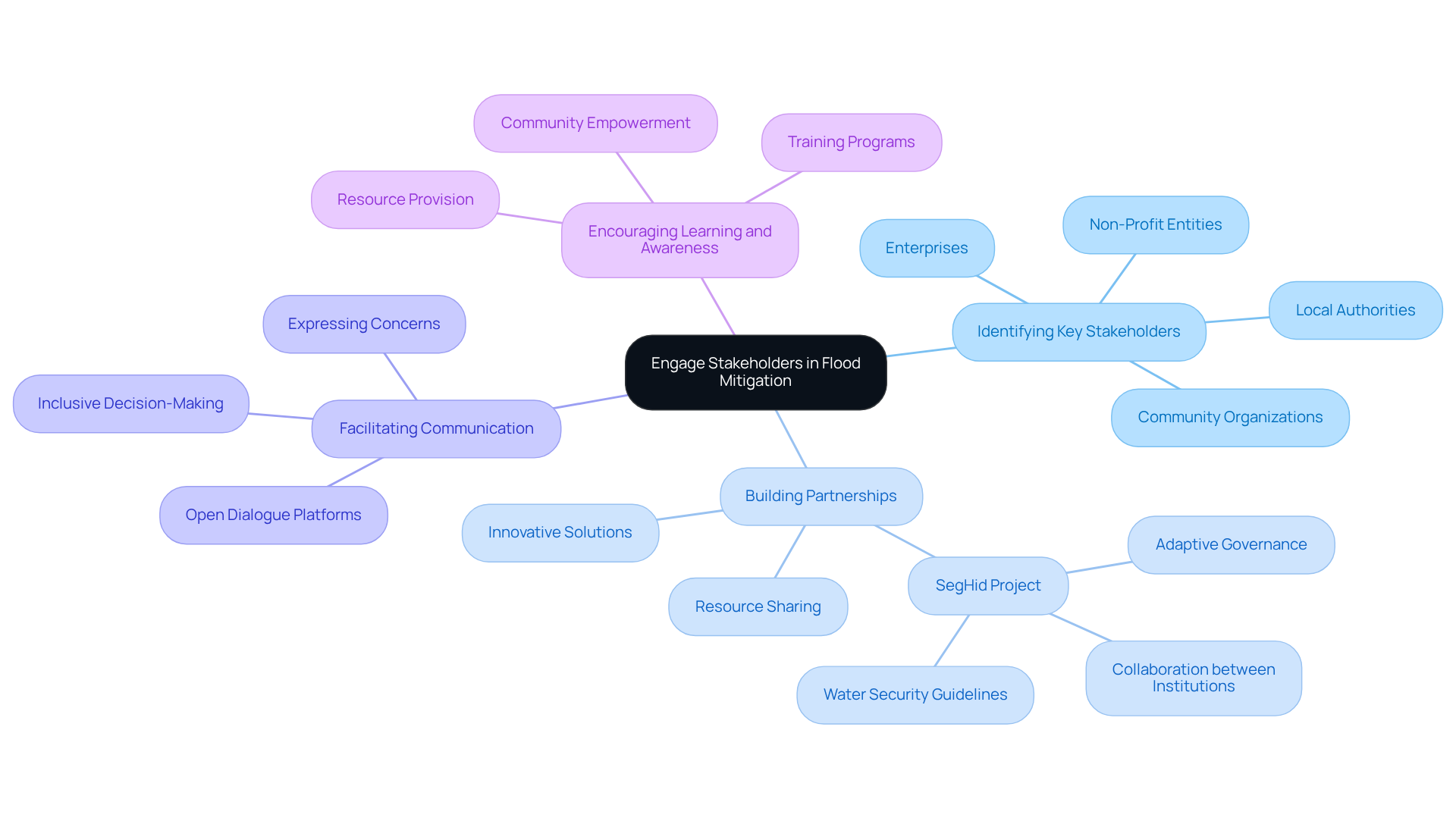Overview
Flood mitigation in urban areas is a critical issue that requires effective management strategies such as prevention, preparedness, response, and recovery. Addressing the challenges posed by inadequate drainage systems and rapid urbanization is essential. Engaging stakeholders through collaboration and communication not only fosters understanding but also leads to the development of tailored and effective flood management solutions.
Consider the implications of insufficient drainage and the rapid pace of urban growth. These factors complicate the landscape of flood management, necessitating a comprehensive approach that includes legal and regulatory considerations. By recognizing these complexities, we can better appreciate the need for robust flood mitigation strategies.
The benefits of effective flood management are clear:
- Reduced risk to lives and property
- Enhanced community resilience
- Improved urban planning outcomes
As we navigate these challenges, it becomes increasingly evident that collaboration among stakeholders is paramount.
In conclusion, addressing urban flood mitigation requires a multifaceted approach that combines strategic planning with active stakeholder engagement. It is imperative to take action now to develop solutions that will safeguard our communities against the impacts of flooding.
Introduction
Flooding in urban areas represents an escalating crisis that jeopardizes infrastructure, ecosystems, and communities. As cities grow and climate change exacerbates weather patterns, the urgency for effective flood mitigation strategies intensifies. This article examines the fundamental principles of flood management, highlighting innovative techniques and collaborative approaches that empower stakeholders to tackle urban flooding.
How can cities not only react to but also proactively avert the devastating consequences of floods amid rapid urbanization and environmental transformation?
Understand the Principles of Flood Mitigation
Flood mitigation in urban areas encompasses a comprehensive suite of strategies designed to reduce the effects of flooding on these environments. Understanding these key principles is essential for stakeholders aiming to develop effective water control plans that address both immediate and ongoing needs.
-
Prevention is paramount. This involves implementing measures to avert flooding, such as preserving natural waterways and enhancing drainage systems.
-
Next is Preparedness. Establishing robust strategies and frameworks enables efficient responses during inundations, including the deployment of early warning systems and emergency response protocols.
-
During a water disaster, the Response phase is critical. Prompt actions, such as mobilizing emergency services and evacuating affected areas, are essential to minimizing damage.
-
Finally, Recovery focuses on restoring normalcy post-disaster. This includes rebuilding infrastructure and offering support to communities impacted by flooding.
By grasping these principles, stakeholders can create thorough water control plans that effectively incorporate flood mitigation in urban areas to meet both short-term and long-term requirements.

Identify Urban Flooding Challenges
Urban flooding poses significant challenges that must be addressed decisively:
- Inadequate Drainage Systems: Numerous urban areas are hindered by outdated or insufficient drainage systems, which fail to manage heavy rainfall effectively, resulting in overflow and subsequent flooding.
- Rapid Urbanization: The surge in development diminishes permeable surfaces, intensifying runoff and raising the risk of inundation.
- Climate Change: Shifting weather patterns contribute to increasingly severe and frequent storms, surpassing the capabilities of current water control systems.
- Poor Land Use Practices: Ineffective zoning and land management often result in the construction of buildings within flood-prone areas, heightening vulnerability.
Recognizing these challenges is the crucial first step in developing targeted strategies for mitigating water overflow.

Implement Effective Flood Mitigation Strategies
Effective flood mitigation in urban areas is essential for managing stormwater and reducing the impact of storms on cities. These strategies include:
- Green Infrastructure: This approach incorporates natural systems such as rain gardens, green roofs, and permeable pavements, which effectively absorb and manage stormwater.
- Improved Drainage Systems: Upgrading existing drainage infrastructure is crucial to handle increased rainfall and runoff. This includes the installation of larger pipes and retention basins to enhance capacity.
- Flood mitigation in urban areas: Restoring natural floodplains allows for the absorption of excess water, which significantly aids in reducing the impact on urban areas.
- Community Engagement: Involving local communities in water management planning ensures that approaches are tailored to specific needs and conditions.
Executing these approaches necessitates cooperation among various participants, including government bodies, urban planners, and community members. By working together, we can create effective solutions to address the complexities of flood management.

Engage Stakeholders in Flood Mitigation Efforts
Involving stakeholders in water management efforts is crucial for developing effective strategies. This process encompasses several key components:
-
Identifying Key Stakeholders: Recognizing individuals and organizations with a vested interest in flood management is essential. This includes local authorities, enterprises, community organizations, and non-profit entities that can impact or be influenced by water hazards.
-
Building Partnerships: Establishing collaborative relationships among stakeholders facilitates the sharing of resources, knowledge, and expertise. Successful collaborations can lead to innovative solutions and more effective water control strategies. For instance, the SegHid project in Brazil exemplifies how collaboration between institutions can enhance adaptive governance and water security in response to climate challenges. This project focuses on creating guidelines for water management that consider technical, participatory, and sustainability aspects, which are vital for addressing the increasing risks of inundation intensified by rapid urbanization and climate change.
-
Facilitating Communication: Creating platforms for open dialogue is vital. Stakeholders should have opportunities to express concerns, share ideas, and contribute to decision-making processes. This inclusive approach fosters trust and ensures that diverse viewpoints are considered in water disaster planning.
-
Encouraging Learning and Awareness: Providing training and resources to interested parties enhances their understanding of water-related hazards and reduction methods. Educational initiatives empower communities to take proactive measures, thereby increasing resilience against flooding.
The effective involvement of interested parties not only improves the quality of flood mitigation in urban areas but also enhances community resilience and preparedness, ultimately contributing to more sustainable urban environments. By engaging diverse stakeholders, including those served by Harbinger Land, the strategies developed for flood mitigation in urban areas can be more tailored and effective in addressing the unique challenges posed by urban flooding.

Conclusion
Flood mitigation in urban areas presents a significant challenge that demands a comprehensive understanding of various strategies and principles. By prioritizing prevention, preparedness, response, and recovery, stakeholders can effectively tackle the complexities associated with urban flooding. Each phase is crucial not only for managing immediate risks but also for fostering long-term resilience within communities.
The article highlights the pressing challenges of urban flooding, including:
- Inadequate drainage systems
- Rapid urbanization
- Climate change
- Poor land use practices
It underscores the necessity of implementing effective strategies—such as green infrastructure, enhanced drainage systems, and active community engagement—to address these issues. By acknowledging and confronting these challenges, stakeholders can develop tailored solutions that bolster urban flood resilience.
Collaboration among diverse stakeholders is paramount. Engaging local authorities, community organizations, and residents in the flood mitigation process is essential for devising innovative and effective strategies. As urban areas increasingly confront the threats posed by flooding, it is imperative for all involved parties to unite, share knowledge, and cultivate a culture of preparedness. This collective effort will not only enhance flood management but also contribute to the creation of sustainable urban environments capable of withstanding the challenges posed by climate change and rapid development.
Frequently Asked Questions
What is flood mitigation in urban areas?
Flood mitigation in urban areas refers to a comprehensive suite of strategies designed to reduce the effects of flooding on these environments.
What are the key principles of flood mitigation?
The key principles of flood mitigation include Prevention, Preparedness, Response, and Recovery.
What does the Prevention phase involve?
The Prevention phase involves implementing measures to avert flooding, such as preserving natural waterways and enhancing drainage systems.
How does Preparedness contribute to flood mitigation?
Preparedness involves establishing robust strategies and frameworks that enable efficient responses during inundations, including deploying early warning systems and emergency response protocols.
What actions are taken during the Response phase of flood mitigation?
During the Response phase, prompt actions such as mobilizing emergency services and evacuating affected areas are essential to minimizing damage.
What is the focus of the Recovery phase in flood mitigation?
The Recovery phase focuses on restoring normalcy post-disaster, which includes rebuilding infrastructure and offering support to communities impacted by flooding.
Why is understanding these principles important for stakeholders?
Understanding these principles is essential for stakeholders aiming to develop effective water control plans that address both immediate and ongoing needs related to flood mitigation.
List of Sources
- Engage Stakeholders in Flood Mitigation Efforts
- Fig. 3. Examples of quotes translation from the stakeholders'... (https://researchgate.net/figure/Examples-of-quotes-translation-from-the-stakeholders-interviews-into-variables-and_fig1_329774803)




